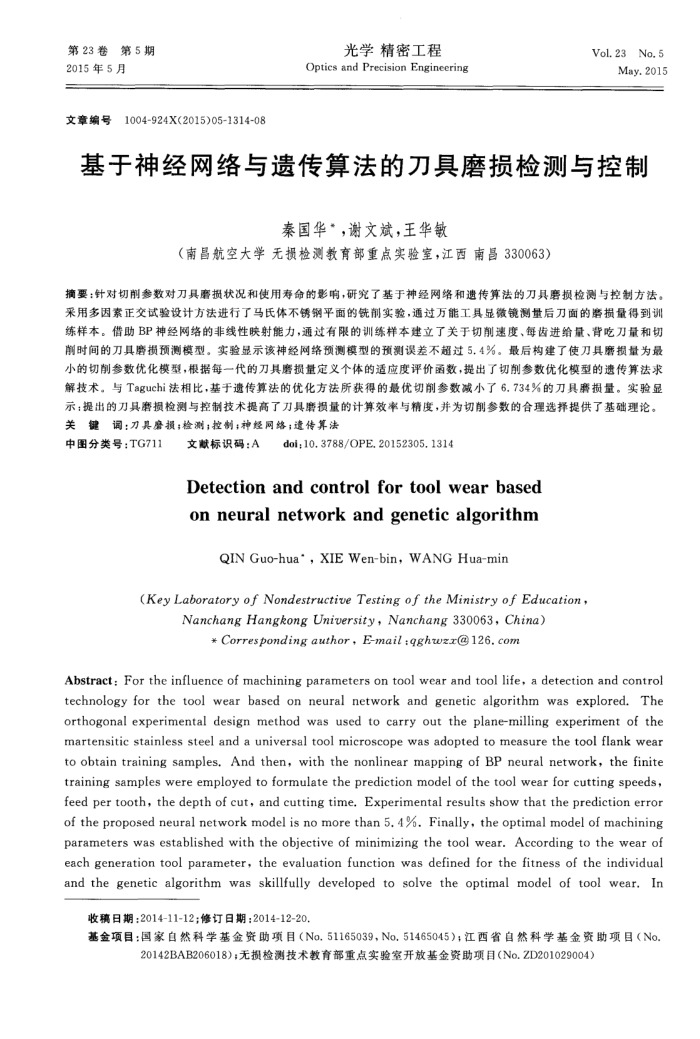基于神经网络与遗传算法的刀具磨损检测与控制
内容简介
 第23卷第5期 2015年5月
第23卷第5期 2015年5月文章编号1004-924X(2015)05-1314-08
光学精密工程
Optics and Precision Engineering
Vol.23No.5
May.2015
基于神经网络与遗传算法的刀具磨损检测与控制
秦国华”,谢文斌,王华敏
(南昌航空大学无损检测教育部重点实验室,江西南昌330063)
摘要:针对切削参数对刀具磨损状况和使用寿命的影响,研究了基于神经网络和遗传算法的刀具磨损检测与控制方法。采用多因索正交试验设计方法进行了马氏体不锈钢平面的铣削实验,通过万能工具显微镜测量后刀面的损量得到训练样本。借助BP神经网络的非线性映射能力,通过有限的训练样本建立了关于切削速度、每齿进给量、背吃刀量和切削时间的刀具磨损预测模型。实验显示该神经网络预测模型的预测误差不超过5.4%。最后构建了使刀具磨损量为最小的切参数优化模型,根据每一代的刀具磨损量定义个体的适应度评价函数,提出了切削参数优化模型的遗传算法求解技术。与Taguchi法相比,基于遗传算法的优化方法所获得的最优切削参数减小了6.734%的刀具廉损量。实验显示;提出的刀具磨损检测与控制技术提高了刀具磨损量的计算效率与精度,并为切削参数的合理选择提供了基础理论。关键调:刀具磨损;检测;控制;神经网络;遗传算法
中图分类号:TG711
文账标识码:A
doi;10.3788/OPE.20152305.1314
Detectionandcontrolfortoolwearbased onneuralnetworkandgeneticalgorithm
QINGuo-hua',XIEWen-bin,WANGHua-min
(KeyLaboratoryof NondestructiveTestingof theMinistryof Education
NanchangHangkongUniversity,Nanchang330063,China)
Correspondingauthor,E-mail:qghwzr126.com
Abstract: For the influence of machining parameters on tool wear and tool life, a detection and control technology for the tool wear based on neural network and genetic algorithm was explored. The orthogonal experimental design method was used to carry out the plane-milling experiment of the martensitic stainless steel and a universal tool microscope was adopted to measure the tool flank wear to obtain training samples. And then, with the nonlinear mapping of BP neural network, the finite training samples were employed to formulate the prediction model of the tool wear for cutting speeds, feed per tooth, the depth of cut, and cutting time. Experimental results show that the prediction error of the proposed neural network model is no more than 5.4%.Finally,theoptimal model of machining parameters was established with the objective of minimizing the tool wear. According to the wear of each generation tool parameter, the evaluation function was defined for the fitness of the individual and the genetic algorithm was skillfully developed to solve the optimal model of tool wear. In
收稿日期:2014-11-12;修订日期:2014-12-20
基金项目:国家白然科学基金资助项目(No.51165039,No.51465045);江西省自然科学基金资助项目(No.
20142BAB206018);无损检测技术教育部重点实验室开放基金资助项目(No.ZD201029004)